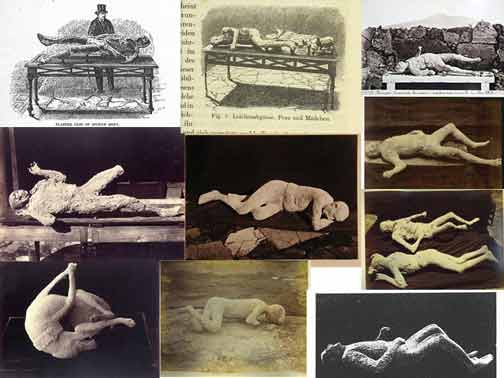Thousands died. But somehow, hundreds of papyrus scrolls survived -- sort of -- in a villa at Herculaneum thought to have been owned at one time by Julius Caesar's father-in-law.
The scrolls contained ancient philosophical and learned writings. But they were so badly damaged -- literally turned to carbon by the volcanic heat -- that they crumbled when scholars first tried to open them centuries later.

Brent Seales, a University of Kentucky computer science professor, specializes in reading ancient manuscripts using computer scans. On the screen behind him is a scan of the earliest complete copy of Homer's Illiad [sic], from the 10th century A.D. On the screen at right is a carbonized scroll from ancient Herculaneum that Seales and his team will try to read using an X-ray CT scan.

This is one of the papyrus scrolls that survived the volcanic destruction of the Roman town of Herculaneum in AD 79. These scrolls, about 3,000 years old, are kept at a museum in Paris, France.
The remaining scrolls, stored away in Italy and France, haven't been read -- or even unrolled -- since 79 AD.
Now, a computer scientist from the University of Kentucky hopes that modern digital technology will allow him to peer inside two of the fragile scrolls -- without physically opening them -- and unlock secrets they have held for almost 2,000 years.
Brent Seales, the Gill professor of engineering in UK's computer science department, will use an X-Ray CT scanning system to collect interior images of the scrolls' rolled-up pages. Then, he and his colleagues hope to digitally "unroll" the scrolls on a computer screen so scholars can read them.
"It will be a challenge because today these things look more like charcoal briquets [sic] than scrolls," Seales said last week. "But we're using a non-invasive scanning system, based on medical technology, that lets you slice through an object and develop a three-dimensional data set without having to open it, just as you would do a CT scan on a human body."
The two scrolls that Seales and his team will work on are stored at the French National Academy in Paris. The UK group will spend July working there.
Their system was developed at UK through the EDUCE project, or Enhanced Digital Unwrapping for Conservation and Exploration, which Seales launched through a grant from the National Science Foundation.
Experts say that if the UK system works as well as hoped, it could provide a safe new way to decipher and preserve more scrolls from Herculaneum, as well as other ancient books, manuscripts and documents that are too fragile to be opened.
"No one has yet really figured out a way to open them," says Roger Macfarlane, a professor of classics at Brigham Young University who also has worked on scrolls from Herculaneum. "If Brent is successful it would be a huge, potentially monumental step forward."
Seales admits that there are hurdles, the biggest being the carbon-based ink thought to have been used on the scrolls. He says that since the papyrus in the scrolls was turned to carbon by the fury of Vesuvius, it might be impossible to visually separate the writing from the pages, even with powerful computer programs.
"The open question is, will we be able to read the writing?" Seales said. "There is a chance that we won't be able to do it with our current machine, and that we'll have to re-engineer some things. But if that's the case, that's what we will do."
Seales, who is from Buffalo, N.Y., grew up with two passions: computers and the humanities. His double major in undergraduate school was computer science and violin. While working on computer imaging in graduate school, Seales became interested in how that technology might be used to digitally preserve old manuscripts and documents.
By the early 1990s, he was developing systems to read old records that were crumpled and wrinkled with age. As a result, he joined an international computer team that digitized the oldest known complete text of Homer's Iliad, which is stored in Venice, Italy. The project, ultimately completed at UK's Center for Visualization and Virtual Environments, produced new digital images, bringing to life sections of the text from the 10th century B.C. that previously were little more than ink smudges.
Developing a method to virtually unroll and copy ancient documents too delicate for normal handling was the next step. This is the system that Seales and his colleagues will use on the Herculaneum scrolls.


